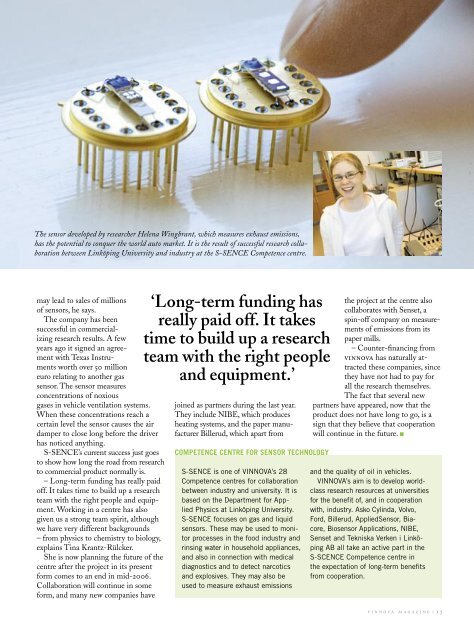Free download - Vinnova
Free download - Vinnova
Free download - Vinnova
Create successful ePaper yourself
Turn your PDF publications into a flip-book with our unique Google optimized e-Paper software.
The sensor developed by researcher Helena Wingbrant, which measures exhaust emissions,<br />
has the potential to conquer the world auto market. It is the result of successful research collaboration<br />
between Linköping University and industry at the S-SENCE Competence centre.<br />
may lead to sales of millions<br />
of sensors, he says.<br />
The company has been<br />
successful in commercializing<br />
research results. A few<br />
years ago it signed an agreement<br />
with Texas Instruments<br />
worth over 50 million<br />
euro relating to another gas<br />
sensor. The sensor measures<br />
concentrations of noxious<br />
gases in vehicle ventilation systems.<br />
When these concentrations reach a<br />
certain level the sensor causes the air<br />
damper to close long before the driver<br />
has noticed anything.<br />
S-SENCE’s current success just goes<br />
to show how long the road from research<br />
to commercial product normally is.<br />
– Long-term funding has really paid<br />
off. It takes time to build up a research<br />
team with the right people and equipment.<br />
Working in a centre has also<br />
given us a strong team spirit, although<br />
we have very different backgrounds<br />
– from physics to chemistry to biology,<br />
explains Tina Krantz-Rülcker.<br />
She is now planning the future of the<br />
centre after the project in its present<br />
form comes to an end in mid-2006.<br />
Collaboration will continue in some<br />
form, and many new companies have<br />
‘Long-term funding has<br />
really paid off. It takes<br />
time to build up a research<br />
team with the right people<br />
and equipment.’<br />
joined as partners during the last year.<br />
They include NIBE, which produces<br />
heating systems, and the paper manufacturer<br />
Billerud, which apart from<br />
COMPETENCE CENTRE FOR SENSOR TECHNOLOGY<br />
S-SENCE is one of VINNOVA’s 28<br />
Competence centres for collaboration<br />
between industry and university. It is<br />
based on the Department for Applied<br />
Physics at Linköping University.<br />
S-SENCE focuses on gas and liquid<br />
sensors. These may be used to monitor<br />
processes in the food industry and<br />
rinsing water in household appliances,<br />
and also in connection with medical<br />
diagnostics and to detect narcotics<br />
and explosives. They may also be<br />
used to measure exhaust emissions<br />
the project at the centre also<br />
collaborates with Senset, a<br />
spin-off company on measurements<br />
of emissions from its<br />
paper mills.<br />
– Counter-financing from<br />
VINNOVA has naturally attracted<br />
these companies, since<br />
they have not had to pay for<br />
all the research themselves.<br />
The fact that several new<br />
partners have appeared, now that the<br />
product does not have long to go, is a<br />
sign that they believe that cooperation<br />
will continue in the future.<br />
and the quality of oil in vehicles.<br />
VINNOVA’s aim is to develop worldclass<br />
research resources at universities<br />
for the benefit of, and in cooperation<br />
with, industry. Asko Cylinda, Volvo,<br />
Ford, Billerud, AppliedSensor, Biacore,<br />
Biosensor Applications, NIBE,<br />
Senset and Tekniska Verken i Linköping<br />
AB all take an active part in the<br />
S-SCENCE Competence centre in<br />
the expectation of long-term benefits<br />
from cooperation.<br />
V I N N O V A M A G A Z I N E | 1 3

















